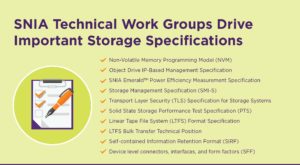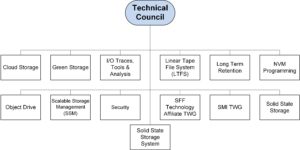 Mark Carlson is the current Chair of the SNIA Technical Council (TC). Mark has been a SNIA member and volunteer for over 18 years, and also wears many other SNIA hats. Recently, SNIA on Storage sat down with Mark to discuss his first nine months as the TC Chair and his views on the industry.
Mark Carlson is the current Chair of the SNIA Technical Council (TC). Mark has been a SNIA member and volunteer for over 18 years, and also wears many other SNIA hats. Recently, SNIA on Storage sat down with Mark to discuss his first nine months as the TC Chair and his views on the industry.
SNIA on Storage (SoS): Within SNIA, what is the most important activity of the SNIA Technical Council?
Mark Carlson (MC): The SNIA Technical Council works to coordinate and approve the technical work going on within SNIA. This includes both SNIA Architecture (standards) and SNIA Software. The work is conducted within 13 SNIA Technical Work Groups (TWGs). The members of the TC are elected from the voting companies of SNIA, and the Council also includes appointed members and advisors as well as SNIA regional affiliate advisors. 
SoS: What has been your focus this first nine months of 2016?
MC: The SNIA Technical Council has overseen a major effort to integrate a new standard organization into SNIA. The creation of the new SNIA SFF Technology Affiliate (TA) Technical Work Group has brought in a very successful group of folks and standards related to storage connectors and transceivers. This work group, formed in June 2016, carries forth the longstanding SFF Committee work efforts that has operated since 1990 until mid-2016. In 2016, SFF Committee leaders transitioned the organizational stewardship to SNIA, to operate under a special membership class named Technology Affiliate, while retaining the long standing technical focus on specifications in a similar fashion as all SNIA TWGs do.
SoS: What changes did SNIA implement to form the new Technology Affiliate membership class and why?
MC: The SNIA Policy and Procedures were changed to account for this new type of membership. Companies can now join an Affiliate TWG without having to join SNIA as a US member. Current SNIA members who want to participate in a Technology Affiliate like SFF can join a Technology Affiliate and pay the separate dues. The SFF was a catalyst – we saw an organization looking for a new home as its membership evolved and its leadership transitioned. They felt SNIA could be this home but we needed to complete some activities to make it easier for them to seamlessly continue their work. The SFF is now fully active within SNIA and also working closely with T10 and T11, groups that SNIA members have long participated in.
SoS: Is forming this Technology Affiliate a one-time activity?
MC: Definitely not. The SNIA is actively seeking organizations who are looking for a structure that SNIA provides with IP policies, established infrastructure to conduct their work, and 160+ leading companies with volunteers who know storage and networking technology.
SoC: What are some of the customer pain points you see in the industry?
MC: Critical pain points the TC has started to address with new TWGs over the last 24 months include: performance of solid state storage arrays, where the SNIA Solid State Storage Systems (S4) TWG is working to identify, develop, and coordinate system performance standards for solid state storage systems; and object drives, where work is being done by the Object Drive TWG to identify, develop, and coordinate standards for object drives operating as storage nodes in scale out storage solutions. With the number of different future disk drive interfaces emerging that add value from external storage to in-storage compute, we want to make sure they can be managed at scale and are interoperable.
SoS: What’s upcoming for the next six months?
MC: The TC is currently working on a white paper to address data center drive requirements and the features and existing interface standards that satisfy some of those requirements. Of course, not all the solutions to these requirements will come from SNIA, but we think SNIA is in a unique position to bring in the data center customers that need these new features and work with the drive vendors to prototype solutions that then make their way into other standards efforts. Features that are targeted at the NVM Express, T10, and T13 committees would be coordinated with these customers.
SoS: Can non-members get involved with SNIA?
MC: Until very recently, if a company wanted to contribute to a software project within SNIA, they had to become a member. This was limiting to the community, and cut off contributions from those who were using the code, so SNIA has developed a convenient Contributor License Agreement (CLA) for contributions to individual projects. This allows external contributions but does not change the software licensing. The CLA is compatible with the IP protections that the SNIA IP Policy provides to our members. Our hope is that this will create a broader community of contributors to a more open SNIA, and facilitate open source project development even more.
SoS: Will you be onsite for the upcoming SNIA Storage Developer Conference (SDC)?
MC: Absolutely! I look forward to meeting SNIA members and colleagues September 19-22 at the Hyatt Regency Santa Clara. We have a great agenda, now online, that the TC has developed for this, our 18th conference, and registration is now open. SDC brings in more than 400 of the leading storage software and hardware developers, storage product and solution architects, product managers, storage product quality assurance engineers, product line CTOs, storage product customer support engineers, and in–house IT development staff from around the world. If technical professionals are not familiar with the education and knowledge that SDC can provide, a great way to get a taste is to check out the SDC Podcasts now posted, and the new ones that will appear leading up to SDC 2016.